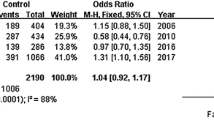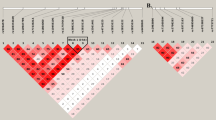Abstract
Migraine, a highly prevalent headache disorder, is regarded as a polygenic multifactorial disease. Single-nucleotide polymorphisms (SNPs) in the genes that involved in sex hormone metabolism may comprise risk for migraine, but the results of previous genetic association studies are conflicting. The aim of this study was to evaluate genetic variants in genes involved in oestrogen receptor and oestrogen hormone metabolism in a Turkish population. A total of 12 SNPs in the ESR1, ESR2, FSHR, CYP19A1, SHBG and NRIP1 genes were genotyped in 142 migraine cases and 141 nonmigraine controls, using a BioMark 96.96 dynamic array system. In addition, gene–gene interactions were analysed using generalized multifactor dimensionality reduction (GMDR) methods. According to GMDR analysis, our results indicated that there was a significant association between migraine and gene–gene interaction among the CYP19A1, FSHR, ESR1 and NRIP1. Single-gene variant analysis showed that a significant association was observed between the TT genotype of rs10046 and migraine susceptibility. When the analysis was performed only in women, the GG genotype of rs2229741 was different between migraineurs and controls. When the female migraine patients were divided into two groups, migraine related to menstruation (MRM) or migraine not related to menstruation (MNRM), GG genotype of rs726281 was significantly associated with MRM. These results suggested that rs10046 could play a potential role in migraine susceptibility in Turkish population. Also, the rare GG genotype of rs726281 appears to influence migraine susceptibility in a recessive manner in MRM subgroup of female patients. In addition, variant GG genotype of rs2229741 may reduce the risk of migraine in Turkish women.

Similar content being viewed by others
References
Brandes J. L. 2006 The influence of estrogen on migraine: a systematic review. JAMA 295, 1824–1830.
Colson N. J., Lea R. A., Quinlan S., MacMillan J. and Griffiths L. R. 2004 The estrogen receptor 1 G594A polymorphism is associated with migraine susceptibility in two independent case/control groups. Neurogenetics 5, 129–133.
Colson N. J., Lea R. A., Quinlan S. and Griffiths L. R. 2006 No role for estrogen receptor 1 gene intron 1 Pvu II and exon 4 C325G polymorphisms in migraine susceptibility. BMC Med. Genet. 7, 12.
Corominas R., Ribases M., Cuenca-León E., Cormand B. and Macaya A. 2009 Lack of association of hormone receptor polymorphisms with migraine. Eur. J. Neurol. 16, 413–415.
Cui Y., Shu X. -O., Cai Q., Jin F., Cheng J. -R., Cai H. et al. 2005 Association of breast cancer risk with a common functional polymorphism (Asp327Asn) in the sex hormone-binding globulin gene. Cancer Epidemiol. Biomarkers Prev. 14, 1096–1101.
Docquier A., Garcia A., Savatier J., Boulahtouf A., Bonnet S., Bellet V. et al. 2013 Negative regulation of estrogen signaling by ERbeta and RIP140 in ovarian cancer cells. Mol. Endocrinol. 27, 1429–1441.
Ghosh J., Joshi G., Pradhan S. and Mittal B. 2012 Potential role of aromatase over estrogen receptor gene polymorphisms in migraine susceptibility: a case–control study from north India. PLoS One 7, e34828.
Ghosh J., Pradhan S. and Mittal B. 2014 Multilocus analysis of hormonal, neurotransmitter, inflammatory pathways and genome-wide associated variants in migraine susceptibility. Eur. J. Neurol. 21, 1011–1020.
Haiman C. A., Dossus L., Setiawan V. W., Stram D. O., Dunning A. M., Thomas G. et al. 2007 Genetic variation at the CYP19A1 locus predicts circulating estrogen levels but not breast cancer risk in postmenopausal women. Cancer Res. 67, 1893–1897.
Hammond G. L. 1995 Potential functions of plasma steroid-binding proteins. Trends Endocrinol. Metab. 6, 298–304.
Haut S. R., Bigal M. E. and Lipton R. B. 2006 Chronic disorders with episodic manifestations: focus on epilepsy and migraine. Lancet Neurol. 5, 148–157.
Headache Classification Subcommittee of the International Headache Society 2004 The international classification of headache disorders. Cephalalgia 24, 9.
Hsu L., Kalucy R., Crisp A., Koval J., Chen C., Carruthers M. et al. 1977 Early morning migraine: nocturnal plasma levels of catecholamines, tryptophan, glucose, and free fatty acids and sleep encephalographs. Lancet 309, 447–451.
Joshi G., Pradhan S. and Mittal B. 2010 Role of the oestrogen receptor (ESR1 PvuII and ESR1 325 C G) and progesterone receptor (PROGINS) polymorphisms in genetic susceptibility to migraine in a north Indian population. Cephalalgia 30, 311– 320.
Kaunisto M., Kallela M., Hämäläinen E., Kilpikari R., Havanka H., Harno H. et al. 2006 Testing of variants of the MTHFR and ESR1 genes in 1798 Finnish individuals fails to confirm the association with migraine with aura. Cephalalgia 26, 1462–1472.
Laflamme N., Nappi R. E., Drolet G., Labrie C. and Rivest S. 1998 Expression and neuropeptidergic characterization of estrogen receptors (ERB and ERB) throughout the rat brain: anatomical evidence of distinct roles of each subtype. J. Neurobiol. 36, 357–378.
Lipton R. B. and Bigal M. E. 2005 The epidemiology of migraine. Am. J. Med. 118, 3–10.
Lou X. -Y., Chen G. -B., Yan L., Ma J. Z., Zhu J., Elston R. C. et al. 2007 A generalized combinatorial approach for detecting gene-by-gene and gene-by-environment interactions with application to nicotine dependence. Am. J. Hum. Genet. 80, 1125– 1137.
World Health Organization 2011 Atlas of headache disorders and resources in the world 2011. World Health Organization.
Oterino A., Pascual J., de Alegría C. R., Valle N., Castillo J., Bravo Y. et al. 2006 Association of migraine and ESR1 G325C polymorphism. Neuroreport 17, 61–64.
Oterino A., Toriello M., Cayón A., Castillo J., Colas R., Alonson-Arranz A. et al. 2008 Multilocus analyses reveal involvement of the ESR1, ESR2, and FSHR genes in migraine. Headache 48, 1438–1450.
Rodriguez-Acevedo A. J., Smith R. A., Roy B., Sutherland H., Lea R. A., Frith A. et al. 2014 Genetic association and gene expression studies suggest that genetic variants in the SYNE1 and TNF genes are related to menstrual migraine. J. Headache Pain 15, 62.
Schürks M., Rist P. M. and Kurth T. 2010 Sex hormone receptor gene polymorphisms and migraine: a systematic review and meta-analysis. Cephalalgia 30, 1306–1328.
Serva W. A., Serva V. M., de Fatima Costa Caminha M., Figueiroa J. N., Albuquerque E. C., Serva G. B. et al. 2011 Course of migraine during pregnancy among migraine sufferers before pregnancy. Arq. Neuropsiquiatr. 69, 613–619.
Smith S. B., Reenilä I., Männistö P. T., Slade G. D., Maixner W., Diatchenko L. et al. 2014 Epistasis between polymorphisms in COMT, ESR1, and GCH1 influences COMT enzyme activity and pain. Pain 155, 2390–2399.
Somerville B. W. 1971 The role of progesterone in menstrual migraine. Neurology 21, 853–859.
Sowers M. R., Jannausch M. L., McConnell D. S., Kardia S. R. and Randolph J. J. F. 2006 Endogenous estradiol and its association with estrogen receptor gene polymorphisms. Am. J. Med. 119, S16–S22.
Wang S. J., Fuh J. L., Lu S. R., Juang K. D. and Wang P. H. 2003 Migraine prevalence during menopausal transition. Headache 43, 470–478.
Acknowledgement
This research is supported by Dicle University Scientific Research Projects (DUBAP), project no: 10-TF-150.
Author information
Authors and Affiliations
Corresponding author
Additional information
[Coşkun S., Yücel Y., Çim A., Cengiz B., Oztuzcu S., Varol S., Özdemir H. H. and Uzar E. 2016 Contribution of polymorphisms in ESR1, ESR2, FSHR, CYP19A1, SHBG and NRIP1 genes to migraine susceptibility in Turkish population. J. Genet. 95, xx–xx
Rights and permissions
About this article
Cite this article
COŞKUN, S., YÜCEL, Y., ÇIM, A. et al. Contribution of polymorphisms in ESR1, ESR2, FSHR, CYP19A1, SHBG and NRIP1 genes to migraine susceptibility in Turkish population. J Genet 95, 131–140 (2016). https://doi.org/10.1007/s12041-016-0625-2
Received:
Revised:
Accepted:
Published:
Issue Date:
DOI: https://doi.org/10.1007/s12041-016-0625-2




